Executive & Team Coaching

In Pursuit of Excellence
Methodology
RESONANCE EXECUTIVE AND TEAM COACHING (RETC) COACHING MODEL
From Unleashing Potential to Maximizing Organizational Productivity
Maximize Organizational Productivity
energize employees to achieve standards of excellence
Coaching: Maximize training and development
Promote growth and collaboration
Generative Conversations
Engage, Implement, Accountability, Sustainability
Improve Individual Performance
examine external factors: resources, systems, processes
examine internal factors: psychological influence, motivation
Coaching: create a climate that promotes growth/development
Mobilize, Influence, Connect
Clarity of Purpose
sense of intentionality
agreement to purpose-driven goals
Coaching: align goals with organizational goals
Align, Clarify, Systematize, Focus
Endless Possibilities
explore present realities, endure challenges
Coaching: shift confusion to clarity/move from inaction to action
Motivate, Inspire, Accelerate Learning
Unleashing Potential
acknowledge strengths, skills that can be developed
Coaching: Introspect, Awareness, Openness
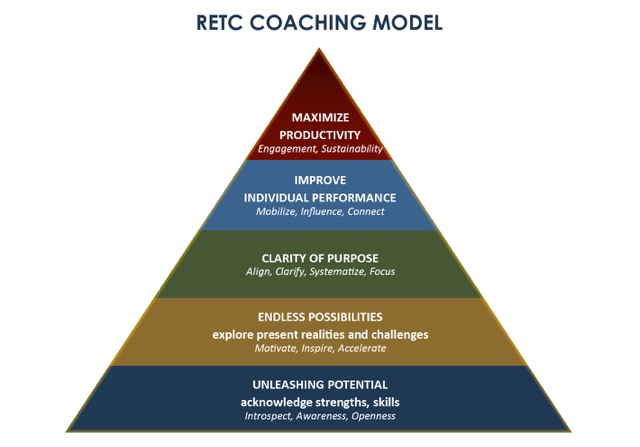
Maximize Organizational Productivity
energize employees to achieve standards of excellence
Coaching: Maximize training and development
Promote growth and collaboration
Generative Conversations
Engage, Implement, Accountability, Sustainability
Improve Individual Performance
examine external factors: resources, systems, processes
examine internal factors: psychological influence, motivation
Coaching: create a climate that promotes growth/development
Mobilize, Influence, Connect
Clarity of Purpose
sense of intentionality
agreement to purpose-driven goals
Coaching: align goals with organizational goals
Align, Clarify, Systematize, Focus
Endless Possibilities
explore present realities, endure challenges
Coaching: shift confusion to clarity/move from inaction to action
Motivate, Inspire, Accelerate Learning
Unleashing Potential
acknowledge strengths, skills that can be developed
Coaching: Introspect, Awareness, Openness

COACHING DELIVERY Resonance Executive and Team Coaching offers customized coaching services from face-to-face coaching, tele-coaching (by phone) or via Skype. The number and extent of the coaching meetings will be discussed at our meeting. We treat all communication with absolute confidentiality.
We provide workshops, seminars, conferences, speaking engagements, both in-house and externally. The latter could be conducted in a company's headquarters, training suite, and hotel conference facilities.
We also offer workshops, seminars, conferences, speaking engagements, training sessions, and expert forums to the public. Delivery categories include - business, education/learning, performance, personal/life, and skills.
ASSESSMENT TOOLS With the use of psychometric instruments and behavioral interviews, our goal is to identify competencies that are evident in a specific person or team, as determined by themselves or others.
Coaching sessions are customized to meet the clients needs, and, as needed, may include 360 feedback from key stakeholders. This helps to identify aggregate results for whom the 360 was generated, therein. to improve individual and team performance and as a complement to other assessment tools. The following are a few of the psychometric measures that we use:
- Team Diagnostic™
- Team Emotional and Social Intelligence Survey 2.0® (TESI 2.0®)
- EQ-i 2.0® & EQ 360™
- MYERS-BRIGGS TYPE INDICATOR® (MBTI®)
- CONFLICT DYNAMICS PROFILE® (CDP®)
- LEADERSHIP PRACTICES INVENTORY® (LPI®)
- PEARMAN™ PERSONALITY INTEGRATOR
- RISK TYPE COMPASS™
TEAM DIAGNOSTIC™ (Team Coaching International) provides a suite of diagnostic tools to teams and stakeholders to help capture a snapshot of a team that highlights core factors that help or hinder sustainable team excellence followed by a roadmap for improving team performance. The Team Diagnostic™ utilizes a systems approach, considering a team as a dynamic entity with a culture, personality, and a set of spoken and unspoken rules for team behavior. Aside from diagnosing the team and its participants, the Team Diagnostic™ includes a Team Leader View™, a Team 360 View™ and an Organization View™ - all based on a practical model of team and organization effectiveness.
The Team Diagnostic™ examines a team and an organization in relation to two dimensions, a Productivity Dimension - teams exist to produce results, therefore, questions explore conditions necessary for teams to be Productive. Further, the culture (or atmosphere) of the team exerts tremendous influence on the team's ability to work together to produce results, so, Positivity (engagement) qualities are measured. Each of the profiles is debriefed and ongoing coaching builds on strengths and addresses areas for growth.
For an overview of each of the views generated by the Team Diagnostic™ Assessment, please see the following:
- Team Diagnostic View™ (Read more)
- Team 360 View™ (Read more)
- Team Leader View™ (Read more)
- Organization View™ (Read more)
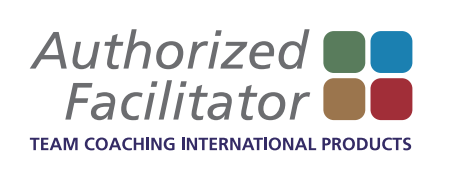
TEAM EMOTIONAL AND SOCIAL INTELLIGENCE SURVEY 2.0® (TESI 2.0®)
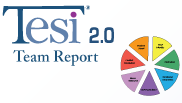
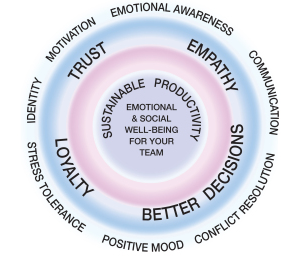
The first scientifically validated assessment for measuring the emotional effectiveness of teamwork. It is a 360 multi-rater report wherein each member of a team rates the team's skills from his/her perspective. This allows team members and leaders to measure seven competencies - Team Identity, Motivation, Emotional Awareness, Communication, Stress Tolerance, Conflict Resolution, and Positive Mood.
The results are generated in a colorful report which includes demographic information on gender, generations, longevity of the team, and a customizable feature which can be used to break out information on sub-teams. The sub-teams may be based on gender, age or age groupings or status, such as supervisor as compared to manager. The report and its breakout graphs offer unique insights, interprets the current strengths and weakness as a team, and guides the team to strategically choose where to enhance its skills. The TESI 2.0® has been used in organizations like Google, American Express, Medtronic, and the U.S. Air Force as well as Haiti, Kosovo, and the West Bank.
EQ-i 2.0® and EQ 360™ Emotional Intelligence can have a tremendous impact on people and the workplace. Emotional intelligence is a set of emotional and social skills that influence the way we perceive and express ourselves, develop and maintain social relationships, cope with challenges, and use emotional information in an effective and meaningful way. While emotional intelligence is not the sole predictor of human performance and development potential, it is proven to be a key indicator of these areas. Emotional intelligence is not a static factor - to the contrary, one's emotional intelligence changes over time and can be developed in targeted areas. Applications of emotional intelligence include: leadership development, selection, organizational development, executive coaching, and team building.
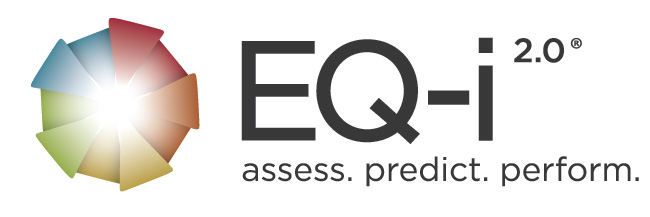
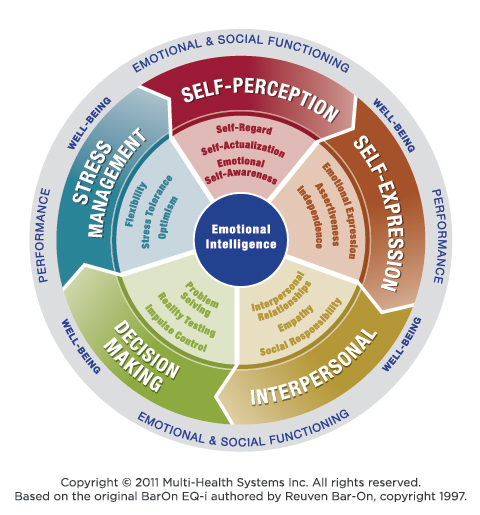
While the EQ-i 2.0® identifies the level of emotional and social functioning based on a client's responses, the EQ 360™ assessment is a multi-rater measure of emotional intelligence designed to provide a complete 360-degree view of a person's emotional and social functioning. The EQ 360™ identifies key employee strengths that can be leveraged to the benefit of the organization, as well as identify impediments to high performance that could be improved.
VIA® CLASSIFICATION OF CHARACTER STRENGTHS Via Institute On Character produced a self-assessment character survey that has been used in hundreds of research studies and taken by over 2.6 million people in over 190 countries.
Character Strengths are the personality characteristics that make you authentic, unique, and feeling engaged. Research has demonstrated that knowing and applying one's character strengths can have a significant impact on quality of life, as well as a positive effect on relationships and personal and professional growth and development
The VIA® Classification of Character Strengths is compromised of 24 character strengths that fall under six broad virtue categories: wisdom, courage, humanity, justice, temperance, and transcendence. Each person possesses all 24 of the VIA character strengths in varying degrees to make up one's own unique profile. The character strengths are morally and universally valued, encompass our capacities for helping ourselves and others, and produce effects when we express them.
The VIA® Pro Team Report, in turn, was designed when working with a team to better understand and utilize a team's configuration of character strengths and to improve overall functioning and performance. By providing multiple perspectives, the VIA® Pro Team Report allows you to develop your team on many levels, to enhance team connectedness, performance, and engagement.
www.viacharacter.org
MYERS-BRIGGS TYPE INDICATOR® (MBTI®) The MBTI provides individuals with a greater understanding of their own and others' personality preferences. The MBTI® is widely used for individuals, groups, and organizational development. The measure consists of four dichotomous scales resulting in 16 personality types, each represented by a four-letter code indicating the preference for each of the dichotomies.
The MBTI® is very versatile and widely used for many purposes - identifying leadership styles, team building and team development, organizational change, and improving communication. The measure can provide an Individual Profile, a Team Report, a Decision-Making Style Report, and a Communication Style Report. In addition, the MBTI® can provide an Interpretive Report for Organizations.
The result of using the MBTI® helps participants and company teams to work more effectively.
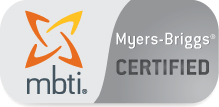
CONFLICT DYAMICS PROFILE® (CDP-I®) Conflict Dynamics Profile® (CDP-I®) from The Center for Conflict Dynamics, Eckerd College, is an assessment instrument dealing with conflict behaviors in the workplace. It provides a powerful way to improve self-awareness of what triggers conflict in individuals and examines how a person responds to conflict. The ability to manage conflict effectively represents a strategic business advantage. It reduces costs, increases productivity, retains top performers, and helps to manage risk (ex. prevent violence, sabotage, and vandalism).
The basic premise of the measure is knowing where a person is at any given point, in relation to conflict, and the CDP-I® provides you with that knowledge. The CDP-360® is a multi-rater version of the CDP-I® instrument and it provides feedback from boss, peers, and direct reports.
The CDP-I® and the CDP-360® explores workplace "hot buttons" - behaviors in others that can trigger irritation in an individual. Both instruments can be utilized with supervisors and employees; the CDP-360® with managers and executives.
Conducting a team intervention with the CDP-I® and CDP-360® can be a starting point for establishing guidelines for handling conflict in the future. As well, effective conflict management is one of the primary development needs of leaders and managers. Effectiveness in the four Active/Constructive scales (Perspective Taking, Creating Solutions, Expressing Emotions, and Reaching Out) is related to promotion and the perception of excellent leadership skills.
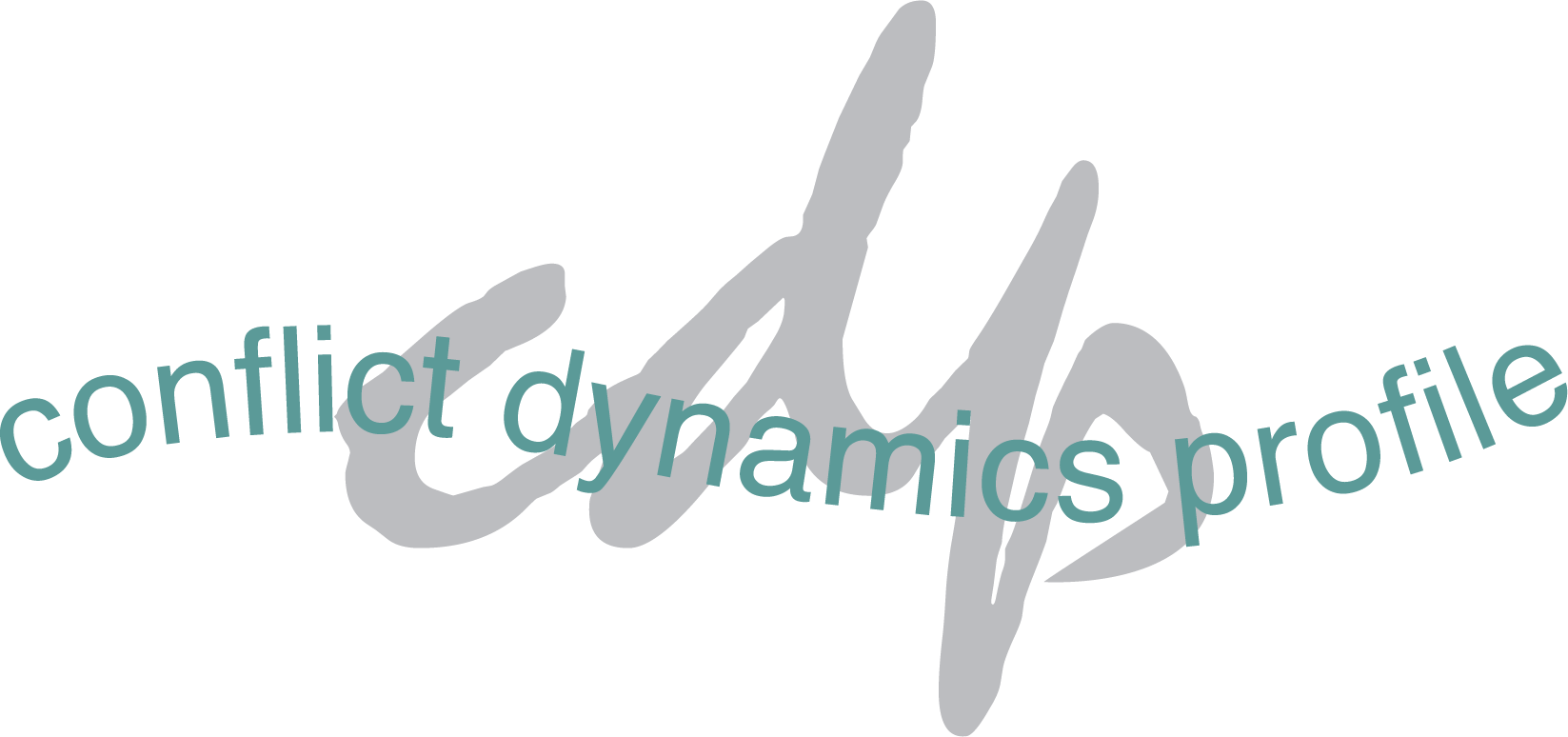
LEADERSHIP PRACTICES INVENTORY® (LPI®) LEADERSHIP PRACTICES INVENTORY® (LPI®), the cornerstone of the Leadership Challenge® by Jim Kouzes and Barry Posner, helps to measure and build leadership skills. Over three million people have used the Leadership-Practices Inventory® as a first step to reach their leadership best.
The Leadership Practices Inventory® is a questionnaire that leaders complete in order to rate themselves on the frequency with which they believe they engage in a number of behaviors. Five to ten other people - typically selected by the leaders - complete the LPI Observer®, indicating the frequency with which they think the leader engages in each behavior.
The LPI 360® (360-multi-rater instrument) is an observer-based tool for leaders and managers at all levels in an organization that incorporates the LPI® Self instrument (completed by the leader) and the LPI® Observer that gathers important insight from bosses, co-workers, direct reports, and others who have direct experience of the individual leader in a leadership role.
The LPI® Individual includes the use of the LPI Self instrument® only, typically used as a measure of an individual's own leadership behaviors.

PEARMAN™ PERSONALITY INTEGRATOR The Pearman™ Personality Integrator examines how someone interacts with the external or internal world, how they take in information and make decisions, and the combination of those individual pieces.
Further, insight is provided by assessing an individual's flexibility, agility, and resilience using the Pearman FlexIndex™. This model integrates personality with psychological flexibility and agility skills relevant to workplace success, leadership, academic success, relationships, conflict resolution, and other domains of functioning. The Pearman FlexIndex™ measures how employees are able to leverage their psychological resources to operate at peak capacity. The FlexIndex examines competencies in relation to Proactivity (taking action), Composure (remaining calm), Connectivity (connecting with others), Variety-Seeking (seeking out new experiences), and Rejuvenation (coping with increasing pressure).
To be effective in the workplace, employees must be able to adapt and flex to meet the ever-changing needs and demands of the modern organization. Adapting to change and being resilient to setbacks are the operating principles that are needed for success.
The Pearman™ Personality Integrator can be combined with the EQ-i 2.0® to explore personality type and emotional intelligence from an integrated perspective.
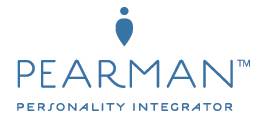
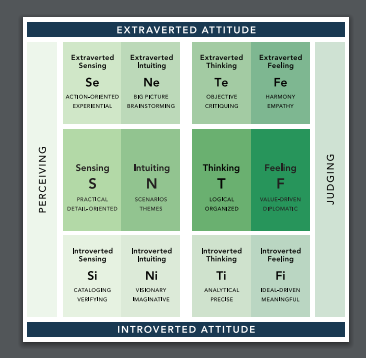
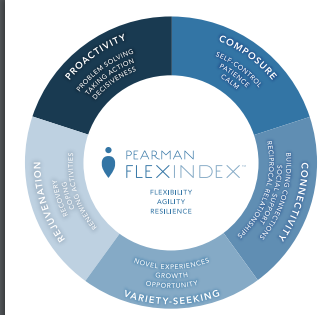
RISK TYPE COMPASS™ There is a potential for risk in almost everything we do; every decision we make at work or at home has some level of risk associated with it. To better understand how an individual or team may approach risk, the Risk Type Compass™ may be used to provide a common language as it is an instrument that assesses the different ways in which individuals perceive risk. Based primarily on personality research, the Risk Type Compass™ uses aspects of an individual's temperament to place them into one of eight risk propensity categories know as Risk Types. An individual's Risk Type will give an indication of how an individual perceives risk, how much uncertainty they can cope with, and how they will react when unexpected events or outcomes occur.
The applications are wide reaching, from individual, leadership and team development, to understanding how executive boards manage organizational risk.
The report is designed to provide a comprehensive overview of an individual's propensity by providing detailed information about their Risk Type, Risk Attitude and overall Risk Tolerance; and highlighting their capability for high risk decision making, or where risk aversion is essential. The measure can be used for individual or leadership development across any occupational domain and includes a comprehensive description of the individual's Risk Type with graphic representation displaying their exact Risk Type positioning.
